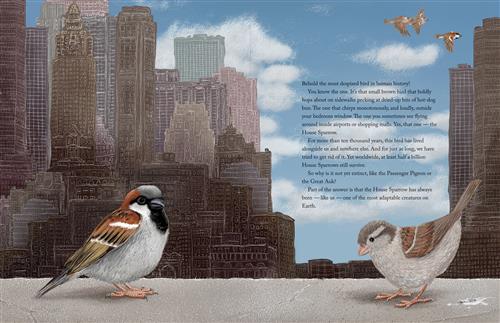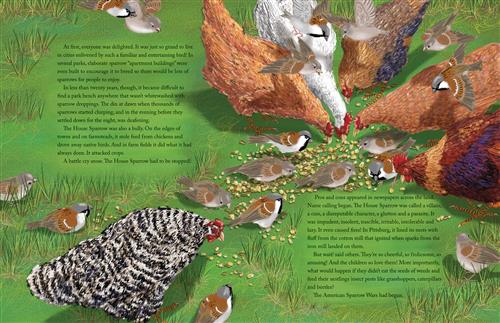“The content encourages us to reflect upon and evaluate the relationship between human beings and animals. This book leaves us with admiration for this feisty bird and hope for our world.” — Friends Journal
Behold the most despised bird in human history!
So begins Jan Thornhill’s riveting, beautifully illustrated story of the House Sparrow. She traces the history of this perky little bird, one of the most adaptable creatures on Earth, from its beginnings in the Middle East to its spread with the growth of agriculture into India, North Africa and Europe. Everywhere the House Sparrow went, it competed with humans for grain, becoming such a pest that in some places “sparrow catcher” became an actual job and bounties were paid to those who got rid of it.
But not everyone hated the House Sparrow, and in 1852, fifty pairs were released in New York City. In no time at all, the bird had spread from coast to coast. Then suddenly, at the turn of the century, as cars took over from horses and there was less grain to be found, its numbers began to decline. As our homes, gardens, cities and farmland have changed, providing fewer nesting and feeding opportunities, the House Sparrow’s numbers have begun to decline again — though in England and Holland this decline appears to be slowing. Perhaps this clever little bird is simply adapting once more.
This fascinating book includes the life history of the House Sparrow and descriptions of how the Ancient Egyptians fed it to the animals they later mummified, how it traveled to Great Britain as a stowaway on ships carrying Roman soldiers, and how its cousin, the Eurasian Tree Sparrow, was almost eradicated in China when Mao declared war on it. A wealth of back matter material is also supplied.
Key Text Features
map
glossary
references
resources
further information
Correlates to the Common Core State Standards in English Language Arts:
CCSS.ELA-LITERACY.RI.3.3
Describe the relationship between a series of historical events, scientific ideas or concepts, or steps in technical procedures in a text, using language that pertains to time, sequence, and cause/effect.
CCSS.ELA-LITERACY.RI.3.7
Use information gained from illustrations (e.g., maps, photographs) and the words in a text to demonstrate understanding of the text (e.g., where, when, why, and how key events occur).
CCSS.ELA-LITERACY.RI.4.3
Explain events, procedures, ideas, or concepts in a historical, scientific, or technical text, including what happened and why, based on specific information in the text.
CCSS.ELA-LITERACY.RI.5.3
Explain the relationships or interactions between two or more individuals, events, ideas, or concepts in a historical, scientific, or technical text based on specific information in the text.
CCSS.ELA-LITERACY.RI.6.2
Determine a central idea of a text and how it is conveyed through particular details; provide a summary of the text distinct from personal opinions or judgments.
“The content encourages us to reflect upon and evaluate the relationship between human beings and animals. This book leaves us with admiration for this feisty bird and hope for our world.” — Friends Journal
Behold the most despised bird in human history!
So begins Jan Thornhill’s riveting, beautifully illustrated story of the House Sparrow. She traces the history of this perky little bird, one of the most adaptable creatures on Earth, from its beginnings in the Middle East to its spread with the growth of agriculture into India, North Africa and Europe. Everywhere the House Sparrow went, it competed with humans for grain, becoming such a pest that in some places “sparrow catcher” became an actual job and bounties were paid to those who got rid of it.
But not everyone hated the House Sparrow, and in 1852, fifty pairs were released in New York City. In no time at all, the bird had spread from coast to coast. Then suddenly, at the turn of the century, as cars took over from horses and there was less grain to be found, its numbers began to decline. As our homes, gardens, cities and farmland have changed, providing fewer nesting and feeding opportunities, the House Sparrow’s numbers have begun to decline again — though in England and Holland this decline appears to be slowing. Perhaps this clever little bird is simply adapting once more.
This fascinating book includes the life history of the House Sparrow and descriptions of how the Ancient Egyptians fed it to the animals they later mummified, how it traveled to Great Britain as a stowaway on ships carrying Roman soldiers, and how its cousin, the Eurasian Tree Sparrow, was almost eradicated in China when Mao declared war on it. A wealth of back matter material is also supplied.
Key Text Features
map
glossary
references
resources
further information
Correlates to the Common Core State Standards in English Language Arts:
CCSS.ELA-LITERACY.RI.3.3
Describe the relationship between a series of historical events, scientific ideas or concepts, or steps in technical procedures in a text, using language that pertains to time, sequence, and cause/effect.
CCSS.ELA-LITERACY.RI.3.7
Use information gained from illustrations (e.g., maps, photographs) and the words in a text to demonstrate understanding of the text (e.g., where, when, why, and how key events occur).
CCSS.ELA-LITERACY.RI.4.3
Explain events, procedures, ideas, or concepts in a historical, scientific, or technical text, including what happened and why, based on specific information in the text.
CCSS.ELA-LITERACY.RI.5.3
Explain the relationships or interactions between two or more individuals, events, ideas, or concepts in a historical, scientific, or technical text based on specific information in the text.
CCSS.ELA-LITERACY.RI.6.2
Determine a central idea of a text and how it is conveyed through particular details; provide a summary of the text distinct from personal opinions or judgments.
| Published By | Groundwood Books Ltd — Apr 1, 2018 |
| Specifications | 44 pages | 8.5 in x 11 in |
| Keywords | birds; animals; adapting; extinction; introduced species; thriving in new environments; agricultural history; changing world; habitats and ecosystems; adaptability; respect for environment; appreciation; resilience; informational text; synthesizing; predicting; connecting; Common Core aligned; CC Literature Key Ideas and Details; CC Literature Integration of Knowledge and Ideas; grade 3; grade 4; grade 5; grade 6; School Library Journal Best Books; New York Public Library Best Books for Kids; |
|
Supporting Resources
(select item to download) |
Excerpt |
| Written By |
JAN THORNHILL<\/strong> is an author and illustrator who brings her fascination with the natural world to her books for children. They include The Tragic Tale of the Great Auk<\/em> (Elizabeth Mrazik-Cleaver Award finalist); I Found a Dead Bird<\/em> (National Parenting Publications Gold Award, Norma Fleck Award, Children’s Literature Roundtables of Canada Information Book Award); The Wildlife 123 <\/em>(UNICEF-Ezra Jack Keats International Award, Governor General’s Award finalist) and The Wildlife ABC<\/em> (Governor General’s Award finalist). Jan has also won the Vicky Metcalf Award. She spends her spare time in the woods obsessively collecting and cataloging wild mushrooms and slime molds. She lives near Havelock, Ontario.<\/p>\n |
| Illustrated by |
JAN THORNHILL<\/strong> is an author and illustrator who brings her fascination with the natural world to her books for children. They include The Tragic Tale of the Great Auk<\/em> (Elizabeth Mrazik-Cleaver Award finalist); I Found a Dead Bird<\/em> (National Parenting Publications Gold Award, Norma Fleck Award, Children’s Literature Roundtables of Canada Information Book Award); The Wildlife 123 <\/em>(UNICEF-Ezra Jack Keats International Award, Governor General’s Award finalist) and The Wildlife ABC<\/em> (Governor General’s Award finalist). Jan has also won the Vicky Metcalf Award. She spends her spare time in the woods obsessively collecting and cataloging wild mushrooms and slime molds. She lives near Havelock, Ontario.<\/p>\n |
| Written By |
|
JAN THORNHILL<\/strong> is an author and illustrator who brings her fascination with the natural world to her books for children. They include The Tragic Tale of the Great Auk<\/em> (Elizabeth Mrazik-Cleaver Award finalist); I Found a Dead Bird<\/em> (National Parenting Publications Gold Award, Norma Fleck Award, Children’s Literature Roundtables of Canada Information Book Award); The Wildlife 123 <\/em>(UNICEF-Ezra Jack Keats International Award, Governor General’s Award finalist) and The Wildlife ABC<\/em> (Governor General’s Award finalist). Jan has also won the Vicky Metcalf Award. She spends her spare time in the woods obsessively collecting and cataloging wild mushrooms and slime molds. She lives near Havelock, Ontario.<\/p>\n |
| Illustrated by |
|
JAN THORNHILL<\/strong> is an author and illustrator who brings her fascination with the natural world to her books for children. They include The Tragic Tale of the Great Auk<\/em> (Elizabeth Mrazik-Cleaver Award finalist); I Found a Dead Bird<\/em> (National Parenting Publications Gold Award, Norma Fleck Award, Children’s Literature Roundtables of Canada Information Book Award); The Wildlife 123 <\/em>(UNICEF-Ezra Jack Keats International Award, Governor General’s Award finalist) and The Wildlife ABC<\/em> (Governor General’s Award finalist). Jan has also won the Vicky Metcalf Award. She spends her spare time in the woods obsessively collecting and cataloging wild mushrooms and slime molds. She lives near Havelock, Ontario.<\/p>\n |
| Audience | ages 9 to 12 / grades 4 to 7 |
| Reading Levels |
Guided Reading W
Lexile 1010L Fountas & Pinnel Text Level W |
| Key Text Features | map; glossary; references; resources; further information |
Nominated, Silver Birch Book Award — Non-Fiction, 2019
Commended, School Library Journal Best Books, 2018
“A complex, dark comedy of human behavior and a tenacious avian species . . . An exceptional selection for nonfiction collections; use it to deepen discussions on the relationship among humans, animals, and the environment.” —School Library Journal, STARRED REVIEW
“. . . masterfully conceived and beautifully illustrated . . . . Superbly designed nonfiction with a powerful environmental message.” —Kirkus, STARRED REVIEW
“Thornhill delivers sound science with breathtaking artwork and beautifully crafted words. . . . readers will gain respect for and understanding of this common, but triumphant, bird.” —Quill & Quire, STARRED REVIEW
“[Thornhill's] engaging and informative avian history bestows worth upon the sparrow's feathery back, recasting it from villain to valuable ally.” —Booklist, STARRED REVIEW
“In her engrossing narrative . . . Thornhill revels in the irony of the sparrows’ “triumph,” even as she comments on complexities that add dimension to the story and point toward their uncertain future.” —Bulletin of the Center for Children's Books
“With lively narrative writing and wonderfully detailed, painterly digital illustrations, Thornhill tells a meticulously researched history of the lowly grain-loving house sparrow …” —Horn Book
“. . . excellent research and storytelling skills . . .” —CM Magazine
“The visual appeal of the artwork is captivating. This book is highly recommended . . . It provides a fresh way of looking at history.” —Resource Links




